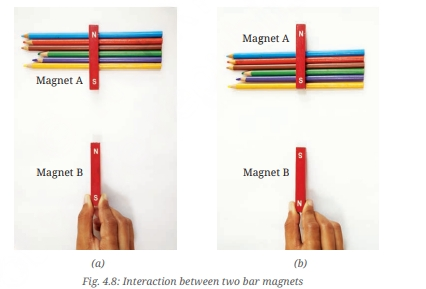Exploring Magnets – Complete Guide For Class 6 Science Chapter 4

Welcome to iPrep, your Learning Super App. Our learning resources for the chapter, Exploring Magnets in Science for Class 6th are designed to ensure that you grasp this concept with clarity and perfection. Whether studying for an upcoming exam or strengthening your concepts, our engaging animated videos, practice questions and notes offer you the best-integrated learning with interesting explanations and examples.
Objectives of Learning The Chapter – Exploring Magnets
The objective of learning the chapter Exploring Magnets in Class 6 Science is to introduce students to the fundamental properties and behavior of magnets. Through this chapter, students will understand the differences between magnetic and non-magnetic materials, learn about magnetic poles, and explore how magnets are used for navigation and other practical applications. Additionally, the chapter aims to develop curiosity and hands-on learning by engaging students in experiments that demonstrate concepts like attraction, repulsion, and the passage of magnetic fields through non-magnetic materials. Ultimately, Exploring Magnets seeks to build a strong foundational understanding of magnetism and its relevance in everyday life.
Introduction: A Tale of Navigation
Reshma, a curious young girl from Kerala, was stuck in her story about sailors lost in a storm. How could they navigate without visible stars? This led her to discover that sailors once used a device called a magnetic compass for navigation, sparking her interest in magnets.
What Are Magnets?
Magnets have been used for centuries, starting with naturally occurring magnets known as lodestones. Today, magnets are made from various materials and come in different shapes. Whether they are bar magnets, U-shaped magnets, or ring magnets, magnets have the unique property of attracting certain materials.

Magnetic and Non-Magnetic Materials
As stated in the chapter Exploring Magnets, Magnets attract some materials but not others. These materials are classified as magnetic or non-magnetic.
Activity: Identifying Magnetic Materials
Students are asked to predict which objects will stick to a magnet and record their observations in a table.
| Object | Material | Prediction | Attracted by Magnet (Yes/No) |
| Pencil | Wood | No | No |
| Eraser | Rubber | No | No |
| Nail | Iron | Yes | Yes |
Magnetic materials like iron, nickel, and cobalt are attracted to magnets, while non-magnetic materials like wood and plastic are not.
Poles of a Magnet
Magnets have two poles—North and South. The poles are where the magnetic force is strongest.
Activity: Observing Magnetic Poles
Students spread iron filings over a paper and observe how they accumulate near the poles of the magnet. No matter how a magnet is divided, both North and South poles always remain, even in the smallest piece of a magnet.
Finding Directions with Magnets
As per the chapter – Exploring Magnets, One of the most intriguing properties of magnets is their ability to find directions.
Activity: Using a Bar Magnet to Find Directions
By suspending a bar magnet horizontally, students observe that it always comes to rest in the north-south direction. This activity demonstrates that Earth itself behaves like a giant magnet, allowing magnets to point towards the poles.
A magnetic compass, with a freely rotating needle, uses this property to help find directions. As mentioned in the chapter exploring Magnets, the needle always aligns along the north-south axis, with the North-seeking end often painted red.
A freely suspended magnet aligns itself along the north-south direction due to Earth’s magnetic field, with the North-seeking end pointing north and the South-seeking end pointing south. This property is unique to magnets, as a non-magnetic iron bar will rest in any direction. This provides a method to test if a metal is a magnet. Based on this principle, the magnetic compass was developed to find directions. The compass contains a needle-shaped magnet that rotates freely and settles in the north-south direction, helping to determine all directions by aligning the compass dial accordingly.
Constructing a Simple Compass
Activity: Making a Homemade Magnetic Compass
Students can create their magnetic compass using simple materials like a cork, a needle, and water. By rubbing the needle with a bar magnet, it becomes magnetized. Floating the needle on a cork in water allows the needle to align with the Earth’s magnetic field, just like a compass.
Attraction and Repulsion Between Magnets
Magnets not only attract objects but can also repel each other depending on the orientation of their poles.
Activity: Investigating Magnetic Interactions
By bringing the North poles of two magnets close together, students observe that the magnets repel each other. Similarly, like poles repel, while unlike poles (North-South) attract.

Magnetic Effects Through Non-Magnetic Materials
Magnets can exert their influence even through non-magnetic materials like wood, cardboard, or plastic.
Activity: Testing Magnetic Influence
Students experiment by placing different non-magnetic materials between a compass needle and a magnet, observing that the compass still deflects. This shows that magnetic fields can pass through non-magnetic substances.
Material Effect on Compass Needle Wood No change Cardboard No change Plastic No change Glass No change
Fun with Magnets: Experiments and Games
Magnets are not just for scientific discovery; they can be used for fun and games!
Magnetic Garland and Maze
By placing steel balls in a maze and using a magnet from below, students can move the balls without touching them directly. Similarly, they can lift steel clips from water using a magnet, showcasing the fascinating power of magnetic forces.
Magnet Cars
Two cars with magnets placed in them will either move toward or away from each other, depending on whether the poles are attracting or repelling.
Magnet Safety and Care
Magnets need to be handled with care to maintain their strength.
- Store magnets in pairs with unlike poles facing each other.
- Avoid dropping, hammering, or heating magnets as these actions can weaken their magnetic properties.
- Keep magnets away from devices like mobile phones or remote controls.
Conclusion
Magnets are everywhere—from the needle of a compass pointing north to the magnetic locks on your school bag. They can attract or repel, find directions, and even influence objects without direct contact. By exploring magnets, we uncover the wonders of invisible forces and their applications in everyday life.
In conclusion, the chapter Exploring Magnets in CBSE Class 6 Science Chapter 4 has introduced us to the fascinating world of magnets. From understanding their unique properties, like attraction and repulsion, to discovering their practical uses, such as navigation through compasses, magnets play a vital role in both science and daily life. By engaging in various activities and experiments, students can deepen their understanding of how magnets interact with different materials and explore the forces they exert. Whether you’re learning about magnetic poles or creating your compass, Exploring Magnets offers an exciting journey into the invisible forces that shape our world.
So, as you delve deeper into the topic of Exploring Magnets, remember to enjoy the experiments while also handling magnets with care. With iPrep’s interactive learning resources, you’ll master every concept of this chapter with ease!
Summary
Let’s now summarize the chapter – Exploring magnets
- Magnets have two poles, North and South, and exert forces of attraction or repulsion.
- Magnetic materials are attracted to magnets, while non-magnetic materials are not.
- A suspended magnet always aligns in the north-south direction, a property used in compasses.
- Magnetic fields can pass through non-magnetic materials like wood and plastic.
- Like poles repel, while unlike poles attract.
- Magnets are fun for experiments, but they must be handled with care.
Practice questions on Chapter 4 - Exploring Magnets
Get your free Chapter 4 - Exploring Magnets practice quiz of 20+ questions & detailed solutions
Practice Now








